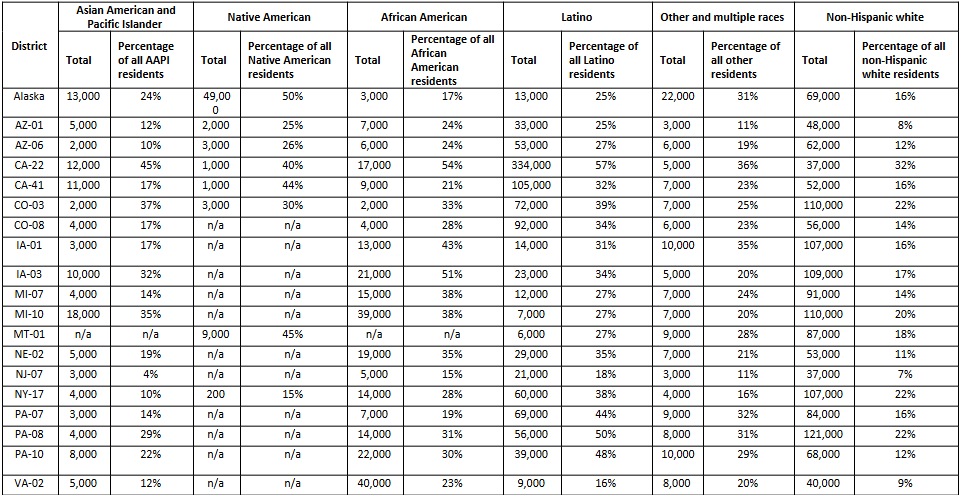(UnidosUS) —
By Rocio Perez, Health Policy Analyst
In February, the U.S. House of Representatives narrowly passed a budget resolution that could set in motion the largest cuts to Medicaid funding in U.S history. In April, the Senate passed its own budget resolution that incorporated the House’s proposed reductions. While people of all races and ethnicities benefit from Medicaid health insurance coverage, communities of color will experience particularly severe harm from the proposed cuts.
Our analysis of Medicaid enrollment by race and ethnicity reveals the potential impact the proposed funding cuts could have on all the communities that rely on Medicaid for health care and community services, including Latinos as well as others.
Keep up with the latest from UnidosUS
Sign up for the weekly UnidosUS Action Network newsletter delivered every Thursday.
Among all residents in selected congressional districts, we find that (Table 1):
- California’s 22nd congressional district has the highest percentage of residents in all racial and ethnic groups who are enrolled in Medicaid.
- In six districts across Alaska, Arizona, Michigan and Montana, Medicaid covers at least a quarter of all Latino residents. In other districts, such as California’s 22nd and Pennsylvania’s 8th congressional districts, Medicaid covers at least half of all Latino residents.
- Medicaid insures between 25% and 50% of both Black and Latino residents in congressional districts across Arizona, California, Colorado, Iowa, Michigan, Nebraska, New York, Pennsylvania and Virginia.
- In half of the districts selected for this analysis, Medicaid covers half or more of all Native American residents, including Alaska’s sole congressional district, California’s 22nd and 41st congressional districts, and Iowa’s 3rd congressional district, among others.
Table 1. Residents of selected Congressional districts who have health insurance through Medicaid, by race and ethnicity, 2023

Source: UnidosUS analysis of 2023 American Community Survey (ACS) data (see methodology appendix, below).
Notes: Latinos are Hispanics of all races. All other racial groups are limited to non-Hispanics. Totals may not sum to due rounding. “N/a” means that, in this category, there were too few survey respondents to yield reliable estimates.
On the other hand, non-Hispanic whites comprise most of Medicaid beneficiaries in 9 out of the 19 congressional districts profiled in this post, including five districts where they make up at least 60% of such beneficiaries and three where more than 70% of people insured by Medicaid are non-Hispanic whites (Table 2).
The other 10 districts discussed below, where people of color make up more than half of Medicaid beneficiaries, have profiles that vary (Table 2):
- In three districts (CA-22, CA-41, and CO-8), Latinos are the largest group of Medicaid beneficiaries.
- In one district (VA-02), African Americans and non-Hispanic whites tie for the largest set of Medicaid beneficiaries.
- Out of six districts where non-Hispanic whites make up a plurality of Medicaid enrollees: in three (AZ-01, AZ-06 and PA-07), Latinos comprise more than a third of all Medicaid beneficiaries; in two (NE-02 and PA-10), Latinos and African Americans together exceed 40% of all Medicaid enrollees; and in one (Alaska), Native Americans are the largest single group of beneficiaries of color.
Table 2. Distribution by race and ethnicity of Medicaid enrollees in selected congressional districts, 2023

Sources: UnidosUS analysis of 2023 ACS data (see methodology, below); Census Bureau’s estimates for the total number of beneficiaries of Medicaid and the Children’s Health Insurance Program in each Congressional district, as compiled and published by the Center for American Progress.
Notes: Latinos are Hispanics of all races. All other racial groups are limited to non-Hispanics. Totals may not sum due to rounding. “N/a” means that, in this category, there were too few survey respondents to yield reliable estimates.
Representatives of each district listed here voted for a budget resolution that authorized the largest Medicaid cuts in American history, even though between 70,000 and 400,000 of their constituents rely on Medicaid for health insurance. This means that people in these districts may soon lose access to affordable, essential health care and protection from costly medical bills. In each district, people of all races and ethnicities will suffer harm, but Latinos and other historically marginalized communities will experience disproportionate harm.
Methodology
The estimates were generated using a model based on ACS data published in IPUMS National Historical Geographic Information System (NHGIS) and IPUMS USA to build a profile of the population in each congressional district. Some data is only published by the Census Bureau for geographic areas that do not precisely align with congressional districts. In these cases, our model compares individual responses to published congressional-level data. This allows us to assign weight to each response based on the likelihood that an individual lives in a particular congressional district. Using these weights, we construct precise estimates of variables that are otherwise unavailable at the congressional district level. Additional methodological details are available upon request.
—
Read More News from UnidosUS
